Biology:List of forageable plants
This article lists plants commonly found in the wild, which are edible to humans and thus forageable. Some are only edible in part, while the entirety of others are edible. Some plants (or select parts) require cooking to make them safe for consumption.
Field guides instruct foragers to carefully identify species before assuming that any wild plant is edible. Accurate determination ensures edibility and safeguards against potentially fatal poisoning. Some plants that are generally edible can cause allergic reactions in some individuals. U.S. Army guidelines advise to test for contact dermatitis, then chew and hold a pinch in the mouth for 15 minutes before swallowing. If any negative effect results, it is advised to induce vomiting and drink a high quantity of water.[1] Additionally, old or improperly stored specimens can cause food poisoning.
Other lists of edible seeds, mushrooms, flowers, nuts, vegetable oils and leaves may partially overlap with this one. Separately, a list of poisonous plants catalogs toxic species.
List
These lists are ordered by the binomial (Latin) name of the species.
Trees and shrubs
| Plant image | Part image | Common name | Binomial name | Distribution | Edible parts and uses | Ref. |
|---|---|---|---|---|---|---|
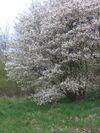 |
100px | Juneberry | Amelanchier lamarckii | Naturalized in Western Europe | Berries (in June), edible raw | [2] |
 |
100px | Barberry | Berberis vulgaris | Europe, North America, northwest Africa, western Asia | Berries (from July), edible raw, dried as a spice or cooked as a jelly | [3] |
 |
100px | Sweet chestnut | Castanea sativa | Throughout Europe and parts of Asia; common in woods and parks | Nuts (October to November). Chestnuts are edible raw or in any other preparation, such as roasted, boiled, stewed or baked. | [4] |
 |
100px | Hazel | Corylus avellana | In many European woodlands, at the edges of woods or in mature hedges | Hazelnuts (from late August to October), edible raw or processed | [5] |
 |
100px | Hawthorn, may-tree | Crataegus monogyna | Native to Europe, northwest Africa and western Asia; naturalized elsewhere | Leaves (when young, in April), edible raw as a salad vegetable Berries (in autumn), edible raw, or made into jellies, jams and syrups, or used as a flavoring |
[6] |
 |
100px | Beech | Fagus sylvatica | Europe south to central Italy, and in mountain forests around the Mediterranean | Nuts (in September or October), edible raw or roasted and salted, or can be pressed for oil | [7] |

|
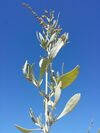
|
Sea purslane | Halimione portulacoides | Seashores and salt marshes of western and southern Europe, and from the Mediterranean to western Asia | Leaves, raw as a salad, or stir-fried | [8] |
 |
100px | Hop | Humulus lupulus | Native to the temperate Northern Hemisphere: Europe, North America, Asia | Young shoots and leaves (until May), edible cooked as a vegetable | [9] |
 |
100px | Walnut | Juglans regia | Native to Central Asia, but naturalized in temperate zones worldwide | Nuts (ripening in September) | [10] |
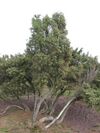 |
100px | Juniper | Juniperus communis | Throughout the Northern Hemisphere in North America, Europe and Asia | Berries, both immature (green) and mature (dark); inedibly bitter when raw, but used as a spice, for beverages, as a jam or roasted and ground as a coffee substitute | [11] |
 |
100px | Oregon-grape | Mahonia aquifolium | North America, occasionally naturalized in Europe | Berries, edible raw (though acidic) or made into a jelly | [12] |
 |
100px | Crabapples | Malus sylvestris and other Malus species | Malus is native to the temperate zone of the Northern Hemisphere, in Europe, Asia and North America. | Fruit (from July), edible raw or, if too bitter, cooked as a jelly (containing much pectin) | [13] |
 |
100px | Medlar | Mespilus germanica | Southeast Europe to West Asia, occasionally naturalized in Britain | Fruit (in November), edible after being bletted for a few weeks | [14] |
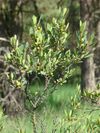
|

|
Bog-myrtle, sweet willow, Dutch myrtle, sweetgale | Myrica gale | Parts of the northern hemisphere, including Japan, North Korea, Russia, Europe and North America | Leaves, dried as tea, or raw as roast chicken stuffing
Nutlets and dried leaves, as a seasoning, including for beer (gruit) |
[15][16] |
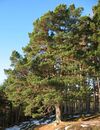 |
100px | Scots pine | Pinus sylvestris | Native to Europe and Asia | Needles (when young, April to August), can be boiled for tea or soaked in olive oil to yield an aromatic oil Nuts, tiny and difficult to extract from the cones, but edible raw |
[17] |

|

|
Mesquite | Prosopis juliflora | Native to Southern America, widely found in arid and hot climates worldwide as an invasive weed | Seed pods, edible raw or boiled, dried and milled to make flour, or fermented to make a mildly alcoholic beverage | |
 |
100px | Wild cherry | Prunus avium | Native to Europe, western Turkey, northwestern Africa, and western Asia; Found in hedgerows and woods, especially beech | Cherries, edible raw | [18] |
 |
100px | Bullace, damson, other wild plums | Prunus domestica subsp. insititia | Prunus species are spread throughout the northern temperate regions of the globe. | Fruit (ripe from early October), edible raw | [19] |
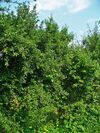 |
100px | Sloe, blackthorn | Prunus spinosa | Native to Europe, western Asia, and locally in northwest Africa; also locally naturalised in New Zealand and eastern North America | Berries, edible raw, but very acidic unless picked after the first few days of autumn frost | [20] |
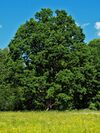 |
100px | English / French oak | Quercus robur | Native to most of Europe, and from Anatolia to the Caucasus, and also to parts of North Africa | Acorns (ripening in September to October), too bitter when raw, but used chopped and roasted as a substitute for almonds, or then ground as a substitute for coffee. After leaching out the bitter tannins in water, acorn meal can be used as grain flour. | [21] |
 |
100px | Golden currant | Ribes aureum | Native to northwest North America | Berries, edible raw but tart | [22] |
 |
100px | Wax currant | Ribes cereum | Native to western North America | Berries, edible raw but possibly semi-toxic | [23][24] |
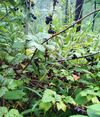 |
100px | Blackcurrant | Ribes nigrum | Native to north-central Eurasia | Berries, used in jams | [25] |
 |
100px | Redcurrant | Ribes rubrum | Native to western Europe | Berries, used in jams and kissel | [26] |
 |
100px | Flowering currant | Ribes sanguineum | Western United States and Canada | Berries, edible raw and used in jams | [27] |
 |
100px | Elder | Sambucus nigra | Europe, North Africa, Central Asia and Anatolia | Flowers (June to July), edible raw, as a salad green, or pickled, or to make tea, or alcoholic beverages Berries (August to October), edible when ripe (turning upside down) and cooked; raw berries are mildly poisonous |
[28] |
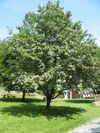 |
100px | Whitebeam | Sorbus aria | Central and southern Europe | Berries, edible raw once overripe (bletted) | [29] |
 |
100px | Rowan, Mountain-ash | Sorbus aucuparia | Native to most of Europe except for the far south, and northern Asia | Berries (August to November), bitter, but can be cooked to form a jelly, or used as a flavouring | [30] |
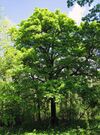 |
100px | Wild service-tree | Sorbus torminalis | Native to Europe, south to northwest Africa, and southeast to southwest Asia | Berries (from September), edible raw, but hard and bitter unless bletted | [31] |
 |
100px | Lime | Tilia × europaea | Occasionally in the wild in Europe, or commonly grown in parks, on roadsides or in ornamental woods | Flowers (in full bloom, June or early July). A tea (popular in France as tilleul) can be made from the dried flowers. Leaves, without the stalks, edible raw as a salad vegetable |
[32] |
| Wild Lowbush Blueberry | Vaccinium angustifolium | Native to the northeastern North America | Berries, edible raw, commonly used in jams and jellies | [1] |
Herbaceous plants
| Plant image | Part image | Common name | Binomial name | Distribution | Edible parts and uses | Ref. |
|---|---|---|---|---|---|---|

|
Yarrow | Achillea millefolium | Native to temperate regions of the Northern Hemisphere | All parts in small quantity, leaves when young | [33][34] | |

|

|
Amaranth, pigweed, tumbleweed | Amaranthus retroflexus | Native to the tropical Americas, but widespread worldwide | Leaves, boiled as a vegetable, or raw with the shoots if young
Seeds, raw or toasted, or ground to flour |
[35] |

|

|
Spear saltbush, common orache | Atriplex patula | Semi-arid deserts and coastal areas in Asia, North America, Europe, and Africa | Young leaves and shoots, raw or cooked as a substitute for spinach | [8] |
 |
100x100px | Ice plant, sour fig | Carpobrotus edulis | South Africa and many zones with a similar climate, including Australia, California and the Mediterranean | Figs (May to July); edible raw | [36] |
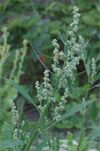 |
100x100px | Fat-hen, wild spinach | Chenopodium album | Worldwide in soils rich in nitrogen, especially on wasteland | Leaves and young shoots; edible raw or prepared as a green vegetable | [37] |
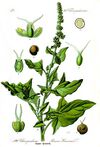 |
Good-King-Henry | Chenopodium bonus-henricus | Most of Europe, West Asia and eastern North America | Young shoots (until early summer) and leaves (until August). The shoots can be cooked like asparagus, and the leaves like spinach. | [38] | |

|

|
Cogongrass | Imperata cylindrica | Native to tropical and subtropical Asia, but found worldwide as an invasive species from 45°N to 45°S | Young inflorescences and shoots, cooked; roots, edible raw when chewed; ash, as a salt substitute | [39] |
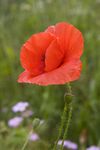 |
100px | Poppy | Papaver rhoeas | Worldwide, principally in the northern temperate zones | Seeds (from September, when the seed heads are dry, gray-brown and holed); edible raw as a spice or flavoring | [40] |

|
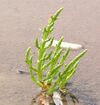
|
Samphire, glasswort, pickleweed, sea beans, sea asparagus | Salicornia species | Seashores and other salty habitats in the northern hemisphere and southern Africa | Young shoots (June or July); edible raw or cooked, also pickled | [41] |

|

|
Bladder campion, maidenstears | Silene vulgaris | As a wildflower in the temperate zones of Europe, Western Asia, North Africa and North America, on dry, sunny, calcareous grassland | Young shoots and leaves, raw, older leaves also cooked; a local specialty in parts of the Mediterranean region | [42] |

|

|
Chickweed | Stellaria media | Worldwide, as an annual in colder climates, and a perennial evergreen elsewhere | Stems and leaves, raw or cooked | [43] |
 |
100px | Dandelion | Taraxacum officinale | Native to Eurasia, naturalized elsewhere | Leaves, edible raw or cooked when older | [44] |
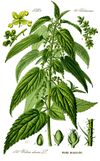 |
100px | Stinging nettle | Urtica dioica | Very common in Europe and Asia, less common in North America | Young shoots and leaves (until May), edible after soaking or boiling as a vegetable, or as a soup or purée | [45] |
See also
- Sansai, foraged plants in Japanese cuisine
- Rubus
- Wild edible plants of Israel / Palestine
References
- ↑ U.S. Department of the Army (2019). The Official U.S. Army Illustrated Guide to Edible Wild Plants. Guilford, CT: Lyons Press. pp. 5–6. ISBN 978-1-4930-4039-1. OCLC 1043567121. https://books.google.com/books?id=T2p7DwAAQBAJ&pg=PA5.
- ↑ Mabey (2012), 73
- ↑ Mabey (2012), 34
- ↑ Mabey (2012), 44
- ↑ Mabey (2012), 52
- ↑ Mabey (2012), 77
- ↑ Mabey (2012), 41
- ↑ 8.0 8.1 Mabey (2012), 104
- ↑ Mabey (2012), 37
- ↑ Mabey (2012), 38
- ↑ Mabey (2012), 33
- ↑ Mabey (2012), 85
- ↑ Mabey (2012), 64
- ↑ Mabey (2012), 74
- ↑ Mabey (2012), 97
- ↑ Elias, Thomas S.; Dykeman, Peter A. (2009). Edible Wild Plants: A North American Field Guide to Over 200 Natural Foods. New York: Sterling. pp. 176. ISBN 978-1-4027-6715-9. OCLC 244766414. https://www.worldcat.org/oclc/244766414.
- ↑ Mabey (2012), 30
- ↑ Mabey (2012), 61
- ↑ Mabey (2012), 62
- ↑ Mabey (2012), 58
- ↑ Mabey (2012), 51
- ↑ Fagan, Damian (2019). Wildflowers of Oregon: A Field Guide to Over 400 Wildflowers, Trees, and Shrubs of the Coast, Cascades, and High Desert. Guilford, CT: FalconGuides. pp. 127. ISBN 978-1-4930-3633-2. OCLC 1073035766. https://www.worldcat.org/oclc/1073035766.
- ↑ Benoliel 2011, p. 163.
- ↑ Blackwell, Laird R. (2006). Great Basin Wildflowers: A Guide to Common Wildflowers of the High Deserts of Nevada, Utah, and Oregon (A Falcon Guide) (1st ed.). Guilford, Conn.: Morris Book Publishing, LLC. pp. 213. ISBN 0-7627-3805-7. OCLC 61461560. https://www.worldcat.org/oclc/61461560.
- ↑ Ministry of Agriculture, Fisheries and Food (1968). Home Preservation of Fruit and Vegetables. HMSO. pp. 16–23.
- ↑ "Kisel – Russian sweet drink" (in en). 2 August 2015. https://milkandbun.com/2015/08/02/kisel-russian-sweet-drink/.
- ↑ "Red-flowering Currant". https://www.fs.fed.us/wildflowers/plant-of-the-week/ribes_sanguineum.shtml.
- ↑ Mabey (2012), 78
- ↑ Mabey (2012), 72
- ↑ Mabey (2012), 68
- ↑ Mabey (2012), 71
- ↑ Mabey (2012), 57
- ↑ Tjandra, Cornelia (2019-05-16). "Yarrow, a Delicious and Nutritious Panacea" (in en-US). https://eattheplanet.org/yarrow-a-delicious-and-nutritious-panacea/.
- ↑ "Common Yarrow: Pictures, Flowers, Leaves & Identification | Achillea millefolium". https://www.ediblewildfood.com/common-yarrow.aspx.
- ↑ Mabey (2012), 112
- ↑ Mabey (2012), 98
- ↑ Mabey (2012), 100; Kallas (2010), 67
- ↑ Mabey (2012), 103
- ↑ "Imperata cylindrica". http://www.pfaf.org/user/Plant.aspx?LatinName=Imperata+cylindrica.
- ↑ Mabey (2012), 88
- ↑ Mabey (2012), 108–111
- ↑ Mabey (2012), 116
- ↑ Mabey (2012), 112–115
- ↑ Benoliel 2011, p. 73.
- ↑ Mabey (2012), xx
Sources
- Benoliel, Doug (2011). Northwest Foraging: The Classic Guide to Edible Plants of the Pacific Northwest (Rev. and updated ed.). Seattle, WA: Skipstone. ISBN 978-1-59485-366-1. OCLC 668195076. https://www.worldcat.org/oclc/668195076.
- Kallas, John (2010). Edible wild plants: wild foods from dirt to plate (1. ed.). Layton, Utah: Gibbs Smith. ISBN 978-1423601500.
- Mabey, Richard (2012). Food for free (2012 ed.). London: Collins. ISBN 978-000-743847-1.
Further reading
- Fleischhauer, Steffen Guido (2005). Enzyklopädie der essbaren Wildpflanzen: 1500 Pflanzen Mitteleuropas mit 400 Farbfotos (3. ed.). Aarau/München: AT-Verlag. ISBN 978-3855028894.
- Lim, T.K.. Medicinal and non-medicinal edible plants. Springer.
- Thayer, Samuel (2006). The Forager's Harvest: a guide to identifying, harvesting, and preparing edible wild plants. Ogema, WI: Forager's Harvest. ISBN 978-0976626602.
de:Wildgemüse
 |



